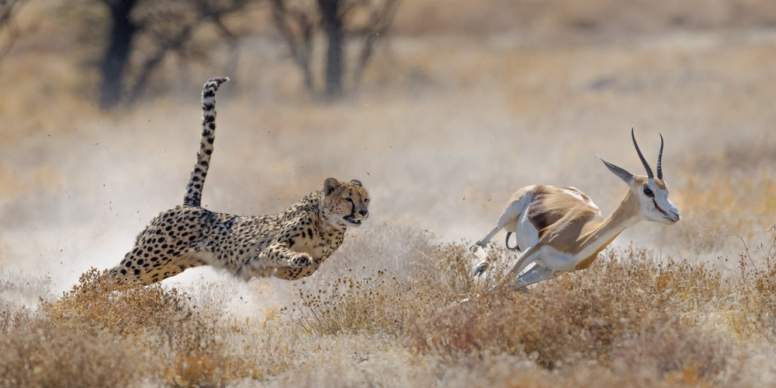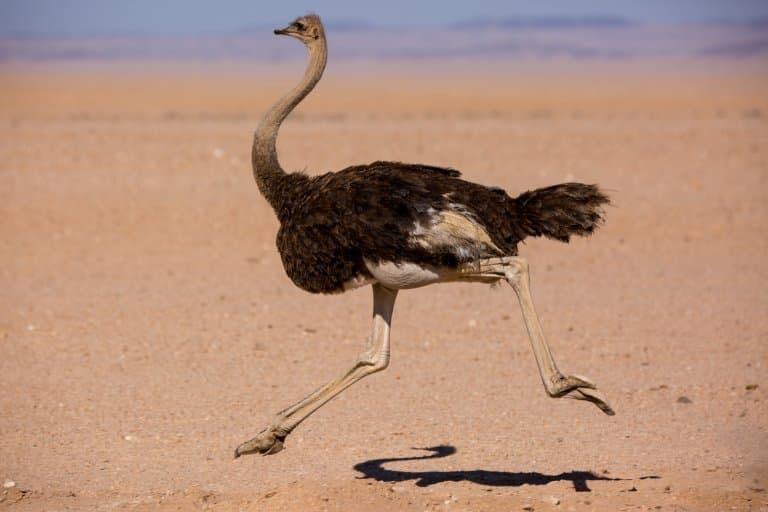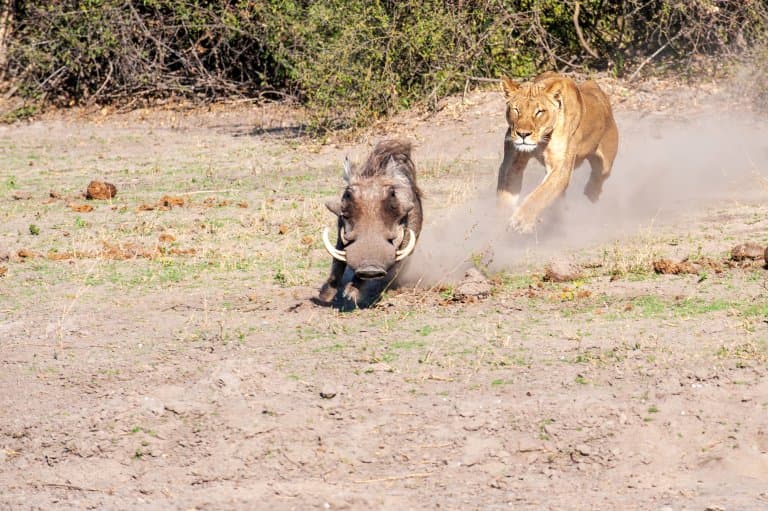Measuring an animal’s true land speed is tricky. And when something is difficult, it’s often tempting to just ‘make it up’ instead. This appears to be what most of the internet has done.
Much like the way that fish miraculously got smaller when tape measures were introduced, animal speeds appear to be slower than they are commonly reported when closely studied.
For the sake of accuracy, we’ve searched high and low to find reliable and verified sources and studies to bring you the definitive top ten fastest land animals on the planet.
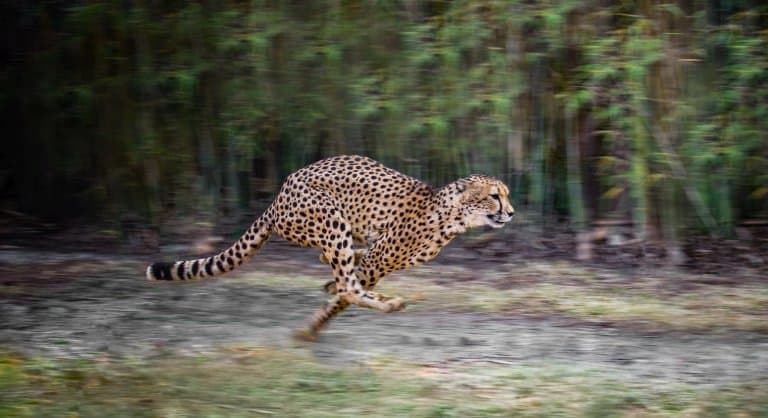
Top 10 Fastest Land Animals
If you were to race an ant, you’d probably win. This makes sense, since your legs are quite a bit longer, despite being a third as numerous.
Extrapolating from this, then, you’d think that longer legs or larger animals should be able to run faster, and while this is true up to a point, you find that an elephant is a lot slower than an ostrich, and the whole theory breaks down.
It turns out that getting bigger is helpful to attaining a high maximum speed up to a point, after which it slows you down.
Being small is a disadvantage, so some studies use alternatives to outright speed to consider body size, such as body lengths per second. This measure would make the Southern Californian mite the fastest organism on the planet at just 0.7mm in size, but able able to travel at 6.5 kph (4.2 mph).
This is an incredible 322 body lengths per second. If a human could run at the same comparative speed to size, it would reach 2,100 kph (1,300 mph).
While body length per second is a fun measure to consider, our research focuses on outright land speed, starting with the absolute fastest running animal on land.
1. Cheetah (Top Speed: 105 kph / 65 mph)
It might come as no surprise that the cheetah is at the top of our list.
This animal is an ambush hunter, capable of the fastest sprint recorded on land. The cheetah’s ability to accelerate is what helps it hit such a high speed before it reaches muscle fatigue.
They have exceptionally efficient energy transfer and flexibility in their muscles, bones, and tendons that help them with a 0-60 of around 3 seconds. 1
2. Pronghorn (Top Speed: 100 kph / 62 mph)
If a hunter evolves to run as fast as a cheetah, it’s for good reason. Predators and prey are in an evolutionary arms race to outcompete one another. As such, the second-fastest animal recorded is an animal that often needs to get away quickly.
Not only can they run extremely fast, but pronghorns can also run for a long time. They’re specially adapted for high oxygen consumption making them great long-distance runners. They can maintain 65kmph (40mph) for at least 11km (7 miles)! 2

3. Dorcas Gazelle (Top Speed: 80 kph / 50 mph)
Coming up just behind the pronghorn is a gazelle that is commonly found inside a cheetah. The Dorcas gazelle is much faster than its name suggests, and can apparently run for hundreds of meters at speeds of around 80kmph.
Almost entirely because of the cheetah, gazelles are fast. And the genus contains about ten species, many of whom have unconfirmed top speeds that exceed this one, so if we were being extremely picky and informed, this list might just contain a cheetah and nine gazelle species. Instead, let Dorcas champion the genus and we’ll just move on. 3
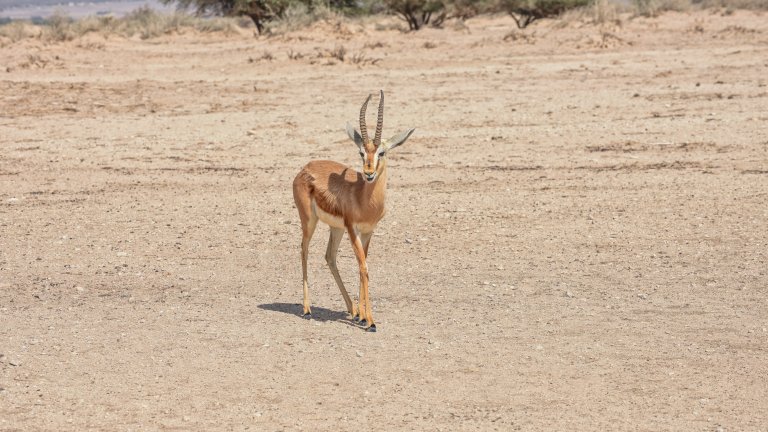
4. The Quarter Horse (Top Speed: 71 kph / 44 mph)
This is a contentious one! The Quarter horse is commonly touted as the fastest horse there is, and there are unsourced reports of their (alleged) maximum being somewhere closer to 88kmph (55mph), which would make them faster than the Dorcas.
The fastest reliably-recorded speed is significantly lower than this, and this is the one we’ll report, but considering that the animal reached this speed with an adult human on its back, it’s a fair assumption that this horse could run faster unencumbered. 4

5. Ostrich (Top Speed: 70 kph / 43.5 mph)
This will be the only animal on our list with two legs! Ostriches are fast, but we can’t seem to agree on quite how fast they are. The figure we’ve quoted commonly shows up in scientific papers, yet doesn’t seem to have an original source. There are more solid reports of ostriches reaching submaximal speeds of 60kmph (37mph), so the figure is believable.
Regardless, they’re thought to be the fastest bipedal animal on land, and capable of high speeds for long distances, too. Their long legs allow them to cover five meters in a single long stride, and their light frame makes them very efficient at using energy. 5
6. Greyhound (Top Speed: 61 kph / 37.9 mph)
Doubling the legs again, we’re back to bendy spines and low centres of gravity with the greyhound.
Though this is a man-made animal, it still counts, and you can be relatively sure of the accuracy of the speed claims, given the millions of drunken onlookers and the billions of industry dollars involved in measuring these things.
Having said that, there are plenty of unsourced claims of these dogs reaching ostrich speeds, so should the mood take you, there is a wide-open market for inter-species sprint competitions there.
Greyhounds have huge quantities of red blood cells relative to other breeds, which, along with their cheetah-like physiology, allows them to accelerate faster than almost any other animal and outpace most of them, too.
Sadly, as with any animal this specialised (and in this case, inbred), they’re a bit fragile and can suffer from illnesses, allergies and other disorders that rarely affect their mongrel peers. 6

7. Moose (Top Speed: 60 kph / 37.3 mph)
This one’s a bit tricky. The closest source comes from a peer-reviewed paper that cites a hard-to-find book by a dead Ukrainian moose biologist.
If you’ve ever taken a look at a Dan Brown book, you’ll understand that just because something’s published, doesn’t mean it’s worth more than the paper it’s printed on, but if you’ve been lucky enough to come close to a moose, you’ll also know the length of its legs alone is convincing.
Moose are probably the most dangerous animal left in Europe, and they’re absolutely huge. Despite this, they have these four spindly pegs underneath them that allow them to trot faster than a terrified human can sprint. You can’t outrun them; your best bet is to climb a tree, as long as you can reach it before they do, but good luck climbing a pine tree in a hurry. Oh, and they can swim, too.
Honourable mention: Moose probably evolved this speed to get away from Brown bears (the Grizzly being the most well-known subspecies), who may well have made this list if there were any credible reports of their running speed. 7
8. Zebra (Top Speed: 57.6 kph / 35.8 mph)
These are essentially sexy punk donkeys with a lot of fast predators, and when you combine the determination of a mule with the intense selective pressure of the African savannah, you end up with something hard to chase down.
Like the moose, their legs are long and slender, and they pack some serious junk in the trunk to move them forward. They’re good with endurance, as well, which gives them an advantage over most ambush predators, as long as they avoid the initial lunge. 8
9. Wildebeest (Top Speed: 51.5 kph / 32 mph)
Aside from killing Mufasa in their blind panic and ushering in an era of exploitation and drought to Pride Rock, wildebeest are otherwise pretty cool. These are very large antelopes, and they work with Zebras to spot predators hiding in the grasses. Sadly, they’re just that little bit slower than their friends, making them more of a decoy for the zebra population than an equal partner.
Again, their predators are ambush hunters like crocs, lions, leopards and cheetahs, so their speed is an adaptation to this. 9

10. Lion (Top Speed: 50.2 kph / 31.19 mph)
The lion tops a lot of lists, but one thing it isn’t the King of is speed. As we mentioned, you could probably squeeze in a lot of different animals between some of these entries if you were fussy enough, so the lion is far from the top of the charts here.
However, it’s still fast! For reference, the fastest individual humanity has offered so far could run at around 38 kmph or 23 mph for a couple of seconds, once. Still, with almost all its prey being faster than it is, the lion uses teamwork and stealth to hunt, making most of its kills by night. 10
Final Thoughts
So, these are the fastest land animals in the world that we could find and verify. Does that mean they’re the top ten fastest animals for sure? Not remotely.
Measuring running speed comes with a lot of complexity.
First of all, animals don’t dump all their energy into running unless it’s very important, and the chances of someone being there to measure it at that moment are slim. So, it’s safe to say that most of these top speeds can be improved upon.
On the other hand, there’s a trade-off when running that relates to the increase in potential accidents as the animal runs faster. Tripping while running away from a cheetah, for example, wouldn’t be a very good idea, so animals may run at slower, more optimal speeds, rather than maximum ones, even when running for their lives.
On top of all this uncertainty, you have to factor in people who make stuff up on the internet, which, sadly, accounts for a lot of the top speeds listed on sites with no references for their claims. This does muddy the waters a bit, as does the fact that kilometres and miles get jumbled up sometimes, resulting in inaccurate reports.
Ultimately, if you’re curious about the truth, always ask where a figure came from. Check your sources and follow them back to the original claim. Oftentimes, you’ll find it was retrieved from within the lower backend of an anonymous blogger and can be safely dismissed.
All the listed animals above have a reference at the end of their description to a paper where their speed been recorded and verified, which you can also find below.
Fact Sources & References
- N. C. C. Sharp (2009), “Timed running speed of a cheetah (Acinonyx jubatus)“, ZSL.
- Stan L. Lindstedt, James F. Hokanson, Dominic J. Wells, Steven D. Swain, Hans Hoppeler & Vilma Navarro (1991), “Running energetics in the pronghorn antelope“, Nature.com.
- Yoram Yom-Tov (1995), “Dorcas Gazelles“, American Society of Mammalogists.
- David Poole (2011), “Highly Athletic Terrestrial Mammals: Horses and Dogs“, Research Gate.
- ABOURACHID, A., & RENOUS, S. (2008), “Bipedal locomotion in ratites (Paleognatiform): examples of cursorial birds“, Sci Hub.
- Usherwood, J. R., & Wilson, A. M. (2005), “No force limit on greyhound sprint speed“, Sci Hub.
- Roy V Rea (2010), “INSIGHTS INTO MOOSE-TRAIN INTERACTIONS“, A Journal Devoted to the Biology and Management of Moose.
- John P. Elliott (1976), “Prey capture by the African lion“, Department of Zoology University of British Columbia, Vancouver.
- John P. Elliott (1976), “Prey capture by the African lion“, Department of Zoology University of British Columbia, Vancouver.
- John P. Elliott (1976), “Prey capture by the African lion“, Department of Zoology University of British Columbia, Vancouver.

